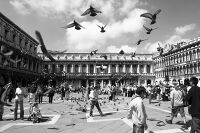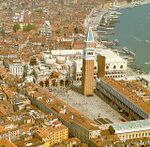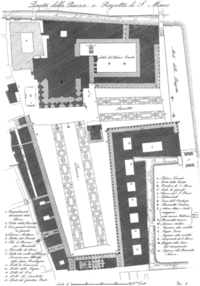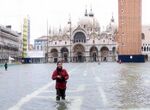Piazza San Marco: Difference between revisions
Created page with "{{Infobox |title = {{PAGENAME}} |titlestyle = |image = 200px |imagestyle = |caption = Piazza San Marco and its famous pigeons |captionstyle =..." |
No edit summary |
||
| Line 24: | Line 24: | ||
|header5 = | |header5 = | ||
|label5 = Brick Pattern | |label5 = Brick Pattern | ||
|data5 = Herringbone | |data5 = [[Herringbone]] | ||
|belowstyle = background:#ddf; | |belowstyle = background:#ddf; | ||
|below = | |below = | ||
Revision as of 22:07, 7 December 2012
 Piazza San Marco and its famous pigeons | |
| Origin | 9th century |
|---|---|
| Paved | 13th century |
| Architect | Andrea Tirali |
| Style | Italian Rennaisance |
| Brick Pattern | Herringbone |
History
Piazza San Marco originated in the 9th century as a small area in front of the original St Mark's Basilica.

It soon became the center of some of the most important religious and political activities of the Serenissima as well as the center of Venetian social life. It is the only public space called piazza, others are called campi. Since 1400, the piazza has been bordered on three sides by the famous triumvirate of Saint Marks Basilica, the Doges' Palace and the Church of San Geminiano. Architect Andrea Tirali constructed the piazza with bricks laid in the herringbone pattern. Napoleon unified the architecture of the square by adding Fabrica Nuova opposite the basilica. It became the piazza as we see it know in 1177, when the Rio Batario, which had bounded it to the west, and a dock, which had isolated the Doge's Palace from the square, were filled in.

Piazza Now
Piazza San Marco these days is for lovers of architecture, culture, history, water, fine dining, and endless shopping opportunities. It is very easy and short walk to it from the train station. Piazza San Marco is a huge open space of glorious architecture - too overwhelmingly beautiful to describe in mere words. Piazza San Marco is one of the main places to catch a gondola ride through the city and also to take public transportation to the many islands. Venice is a city on water and as awesome as it would be it has some disadvantages too. Flood is like unavoidable monster that takes part of the city each year. During the flooding season, tables are set up in the Piazza so that you can walk from one spot to another. Piazza is the perfect place for romantic love seekers as at night, one can listen to the musical entertainment while dining and enjoying the beautiful view.
Flood Problems

During heavy rains water pouring into the drains runs directly into the Grand Canal. Unfortunately Piazza San Marco is at the lowest point in Venice and consequently it is flooded during Acqua Alta the "high water" from storm surges from the Adriatic. In order for Acqua Alta to occur certain events must coincide:
- A very high tide (usually during a full or new moon).
- Low atmospheric pressure.
- A scirocco wind blowing up the narrow, shallow Adriatic Sea, which forces water into the Venetian Lagoon.
It is most likely to happen in late September and April, and especially in the months of October, November, and December. By official definition, acqua alta occurs when the tide is 90 mm (3.54 inches) above normal high tide. There are ways to save the city from this natural phenomenon and rescue works have already started. The Commune of Venice and various international organizations have been working on solutions that range from floodgates at the Lagoon's entrances to raising of pavements in low-lying areas of the city.
See Also
Bibliography
- The Wonder of Piazza San Marco
- Great Public Spaces
- Image of Piazza San Marco
- Ton of information about the Piazza
- Acqua Alta